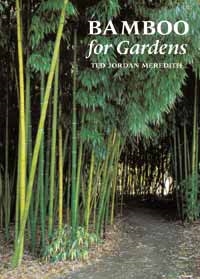Bambusz a kertekben. Bamboo for Gardens, Szerző: Ted Jordan Meredith
Kemény kötés, 408 oldal, 158 színes kép, 5 rajz.
Bárhol is jelenjenek meg, a bambuszok egzotikus atmoszférát keltenek maguk körül. Sajnos keveset használják őket a kertekben, félve a mindent elözönlő természetüktől, vagy a gyenge ellenálló képességük miatt.
Alkalmazásuknál szerepet játszanak a díszítő szempontok, illetve a gyakorlatias szempontok is, úgy mint az árnyékolás vagy az eróziós védekezés, nem beszélve a bambusz hajtások kulináris értékéről, vagy a fás szárú bambuszok strukturális tulajdonságairól.
A trópusi és szubtrópusi bambusz fajták sok lehetőséget rejtenek magukban kertészeti szempontból a melegebb övezetű vidékeken, míg az ellenállóképesebb fajtákat akár Minnesotában (USA), vagy a hűvösebb klímájú Angliában és az európai kontinensen is lehet termeszteni. A bambusz kultúra régi és kiváló hagyományokkal rendelkezik Kelet-Ázsiában, de a nyugati kertépítők és kertészek számára még sok felfedezni valót tartogat.
Ted Jordan Meredith, az elismert bambusz szakértő alapos és sokoldalú feldolgozását nyújtja ezeknek az ősi növényeknek, lefedve eredetüket és történelmüket, formájukat és felépítésüket, művelésüket és eredeztetésüket, a tereprendezésben betöltött szerepüket, rendszertanukat és meghatározásukat. A szerző bepillantást enged a helyzethez megfelelő növény kiválasztásának tudományába, s hasznos tanácsokkal látja el az olvasót, hogyan lehet feltartóztatni vagy gyökerestül kiirtani a mindent elözönlő fajtákat. A könyv nagy része a bambuszok nemzettségének, fajtáinak kultúrnövény-változatainak enciklopédiája. 40 nemzettségből származó több mint 300 bambuszt tárgyal részletesen. A könyv tartalmát, s ezeknek a pompás növényeknek a környezetükre gyakorolt hatását Ted Meredith kitűnő színes képei és vázlatai illusztrálják.
Bamboos evoke an exotic atmosphere wherever they are used — unfortunately, they are too often kept out of our gardens for fear of their invasive qualities or lack of hardiness. In truth, these elegant grasses, encompassing both woody and herbaceous forms, can achieve dramatic yet restrained effects in a range of climates. Their uses include both the ornamental, offering striking foliage and culms, and the practical, such as for screening or erosion control, not to mention the culinary treat of bamboo shoots and the structural qualities of the culm wood. Tropical and subtropical bamboos present many possibilities for landscapes in warmer climates, while the hardier species can be grown as far north as Minnesota in the United States and in the cooler climes of England and continental Europe. Bamboo culture has a long and distinguished legacy in East Asia, but much remains to be explored by Western gardeners and landscapers.
Bamboo expert Ted Jordan Meredith provides a thorough and multifaceted treatment of these ancient grasses, covering origins and history, structure and form, cultivation and propagation, landscaping, and taxonomy and identification. He offers insight into selecting the right plant for the right situation, and presents useful advice on the best methods for containing or eradicating potentially invasive forms. The bulk of the book is an encyclopedia of bamboo genera, species, and cultivars. More than 300 bamboos from 40 different genera are described in detail, including information on size, lighting and temperature requirements, native range, physical characteristics, and landscape and other uses. Meredith's excellent color photos and clear line drawings effectively illustrate both the details and broader effects of these exquisite plants.
